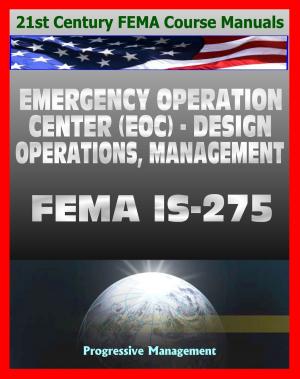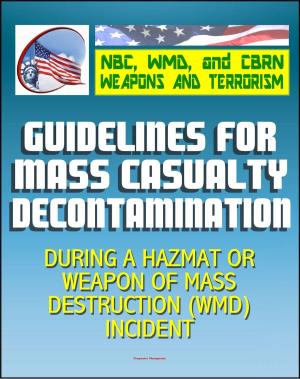21st Century NBC WMD CBRN Weapons and Terrorism: Mass Fatality Management for Incidents Involving Weapons of Mass Destruction - Capstone Document from the U.S. Army and Department of Justice
Nonfiction, Health & Well Being, Medical, Specialties, Forensic Medicine, Social & Cultural Studies, Political Science| Author: | Progressive Management | ISBN: | 9781465916655 |
| Publisher: | Progressive Management | Publication: | March 5, 2012 |
| Imprint: | Smashwords Edition | Language: | English |
| Author: | Progressive Management |
| ISBN: | 9781465916655 |
| Publisher: | Progressive Management |
| Publication: | March 5, 2012 |
| Imprint: | Smashwords Edition |
| Language: | English |
As awareness of the dangers of the 21st century increases and we contemplate the potential for future terrorist incidents, other horrific possibilities don't seem farfetched. Weapons of mass destruction (WMD), like chemical, biological, radiological, nuclear, or high-yield explosives (CBRNE), make a catastrophe more likely. Highly virulent, genetically engineered biological agents could produce a catastrophic incident with death tolls far exceeding those of 1918. Medical examiners and coroners (ME/Cs) must prepare not only to respond to disasters, but also to manage the catastrophic incident. Formulating disaster plans that address all types of disasters may not be enough, unless these plans provide critical guidance for dealing with the unique aspects WMD impose. Unfortunately, there are only a few resources that ME/Cs can use to help formulate plans. The intent of this document is to aid ME/Cs in establishing a uniform mass fatality management strategy that mutually supports and integrates key agencies in the response effort. The general principles and best practices for managing large numbers of fatalities are addressed. This document also directs the reader to those agencies and documents that have more detailed information on specific areas of fatality management. This document focuses on the following topics: the role of ME/Cs and how to manage a catastrophic event; how to mobilize local, state, and federal resources by identifying requirements; the use of a basic mass fatality management strategy; identification of critical variables that influence the fatality management strategy, specifically when remains are chemically or biologically contaminated; the work of other agencies that have addressed various aspects of fatality management; current training opportunities for ME/Cs.
Contents: Agencies with a Mission in Mass Fatality Management * Agencies Involved in Fatality Management Efforts: The Pentagon Experience * State Supporting Agencies * Federal Supporting Agencies * Interagency Coordination * General Planning Considerations: Basic Mass Fatality Management Strategy * Operational Issues That Influence the Mass Fatality Management Strategy * Special Planning Considerations: Managing Chemically Contaminated Remains * Morgue Operations Phase * Abbreviations and Acronyms
As awareness of the dangers of the 21st century increases and we contemplate the potential for future terrorist incidents, other horrific possibilities don't seem farfetched. Weapons of mass destruction (WMD), like chemical, biological, radiological, nuclear, or high-yield explosives (CBRNE), make a catastrophe more likely. Highly virulent, genetically engineered biological agents could produce a catastrophic incident with death tolls far exceeding those of 1918. Medical examiners and coroners (ME/Cs) must prepare not only to respond to disasters, but also to manage the catastrophic incident. Formulating disaster plans that address all types of disasters may not be enough, unless these plans provide critical guidance for dealing with the unique aspects WMD impose. Unfortunately, there are only a few resources that ME/Cs can use to help formulate plans. The intent of this document is to aid ME/Cs in establishing a uniform mass fatality management strategy that mutually supports and integrates key agencies in the response effort. The general principles and best practices for managing large numbers of fatalities are addressed. This document also directs the reader to those agencies and documents that have more detailed information on specific areas of fatality management. This document focuses on the following topics: the role of ME/Cs and how to manage a catastrophic event; how to mobilize local, state, and federal resources by identifying requirements; the use of a basic mass fatality management strategy; identification of critical variables that influence the fatality management strategy, specifically when remains are chemically or biologically contaminated; the work of other agencies that have addressed various aspects of fatality management; current training opportunities for ME/Cs.
Contents: Agencies with a Mission in Mass Fatality Management * Agencies Involved in Fatality Management Efforts: The Pentagon Experience * State Supporting Agencies * Federal Supporting Agencies * Interagency Coordination * General Planning Considerations: Basic Mass Fatality Management Strategy * Operational Issues That Influence the Mass Fatality Management Strategy * Special Planning Considerations: Managing Chemically Contaminated Remains * Morgue Operations Phase * Abbreviations and Acronyms















